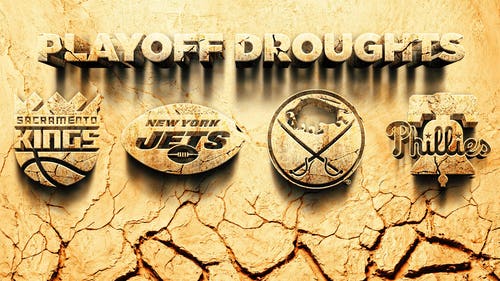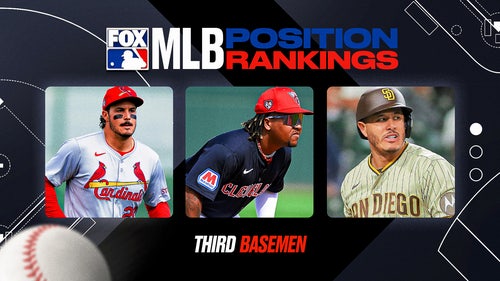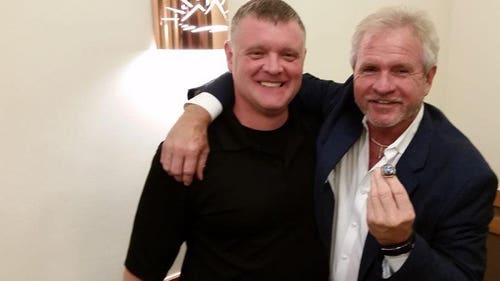
Rangers slugger Willie Calhoun's long, winding journey to his place in The Show
By Jordan Shusterman
FOX Sports MLB Writer
"I don’t think I’m playing baseball no more. I’m done. It’s a wrap."
That’s what Willie Calhoun was thinking toward the end of 2014 — a few months before he would produce one of the most dominant seasons in junior college baseball history and less than three years before he would hit his first major-league home run off future Hall of Famer Justin Verlander.
Over the previous year, it seemed like Calhoun’s baseball dream had started to slip away from him before it had even begun. The Rays had drafted him in the 17th round out of Benicia (California) High School, but he opted to fulfill his commitment to the University of Arizona. On a 2014 Wildcats team that featured three other eventual big leaguers (Kevin Newman, Bobby Dalbec and Scott Kingery), a freshman Calhoun showed very little evidence that the major leagues were in his future.
He started 43 games and hit .247 with zero home runs. The style of hitting preached by the Arizona coaching staff — hitting the ball hard on the ground (particularly at their home ballpark, which was notorious for having a rock-hard infield) — did not jibe with how Calhoun viewed his strengths. But he didn’t feel like he was in position to push back.
"I wasn’t good in college, so I don’t blame the guy for thinking that I sucked," Calhoun told FOX Sports. "But I just wasn’t able to be myself. It was so controlled, I felt like I had to bat a certain way."
After the season, Calhoun was told he was at risk of losing his full-ride scholarship if he didn't improve his performance both on and off the field. He went to the prestigious Cape Cod League and played well, leading the league in doubles — but again, still no homers. He returned to Tucson in the fall with hopes that things would take a turn for the better, but that didn’t happen. By Thanksgiving, his scholarship had been fully taken away, and he no longer had a spot on the team.
"I was super nervous to tell my parents because they were gonna be so disappointed," Calhoun recalled. "Everyone knew I was good at baseball and at a D-I school, but they didn’t know the actual situation. I thought I let everyone down."
Back home in California — where everyone calls him June, short for Junior, as Willie is named after his father — he pondered his next move. "I was getting ready to fill out job applications," he said.
He considered continuing to pursue baseball at Solano, a junior college close to home, but felt like that far of a step down from the Pac-12 wouldn’t be worth his time. It was 2015, and a 20-year-old Calhoun fully believed he was finished playing baseball. "This is where my life just did a complete 180," he said.
Willie Sr., who worked as a corrections officer at San Quentin State Prison, took Willie on a tour of the prison. It put his situation in perspective and reminded him why he couldn’t give up on baseball just yet.
As for where he could continue that baseball dream, it turned out Calhoun had far more advocates than he perhaps realized — and they weren’t all that far away, either.
Chandler Eden first met Willie Calhoun when they were both rising high school seniors in northern California. It was the summer of 2012, and they were both competing at the Area Code Games tryouts at Banner Island Ballpark in Stockton. Eden, a promising right-handed pitcher from Yuba City, was sitting in the stands watching batting practice when he noticed one hitter in particular.
"I remember hearing the crack of the bat, and it sounded a lot different than the other people hitting. There was this little dude, who I didn’t know at the time, hitting absolute mammos," Eden recalled. "He probably hit like eight-to-10 out, couple of ‘em probably left the stadium.
"I was like, ‘Who’s that little 5-[foot]-7 dude?’ They’re like, ‘Oh, that’s Willie Calhoun.’ And I’m like, ‘Is he a first-round prospect?’ And they’re like, 'No, not really.’"
Eden had also been drafted out of high school but chose to head to Corvallis to play for Oregon State, another premier Pac-12 program. Like Willie, Eden was struggling to establish himself as a freshman at a D-I program and ultimately decided to transfer to Yavapai, a junior college about an hour outside of Phoenix, after his freshman year. When Eden heard that Calhoun had left Arizona, he started recruiting right away.
"[Chandler] called me three times, and the first two times, I told him I was done with baseball," Calhoun remembered.
But Eden insisted: Everything would be paid for, and the coach would love to have Calhoun at Yavapai. After mulling it over with his family, he decided it was worth a shot.
Josh Garcia, a former player at Arizona, had spent time as an assistant coach at Yavapai before returning to his alma mater to join the coaching staff the same fall that Calhoun left Tucson. Yavapai head coach Ryan Cougill credits Garcia with vouching for Calhoun’s ability, despite his lackluster freshman season:
"I found out Willie was gonna make a move at winter break, and Josh said, ‘You better get that dude. He’s a pretty good hitter,’" Cougill told FOX Sports.
It didn’t take long for everyone involved to realize that Calhoun was about to have a special season. "Day 1, he took a round of batting practice, and it looked like a professional hitter," Cougill said.
Freed from the hard-on-the-ground mantra drilled into him in Tucson, Calhoun was ready to unlock his dormant power: "As a little kid, I was just trying to launch every time, but I just somehow got hits. Even though I didn’t have power, I was still trying to launch. I pretty much just went back to that."
Calhoun managed to maintain this homer-happy mindset while laying off pitches he couldn’t crush. "A pull approach is a little scary because usually you start fishing off-speed stuff," Cougill explained. "He had this innate ability, which was insane, that he could be ready to pull a fastball and then not chase off-speed pitches down in the zone."
"I knew I had a lot of pull side power," Calhoun said. "A pitcher wasn’t gonna be able to beat me with an inside fastball, so I literally stood on top of the plate and tried to pull every single pitch."
If that sounds a lot like Barry Bonds to you, that’s no accident; Bonds was Calhoun’s favorite player growing up in the Bay Area.
Through 40 games, Calhoun had a Bonds-like 16 homers, which would have been tied for 12th in the country at the end of the season, had he stopped there.
He did not stop there.
Over the span of five double-headers in April, Calhoun homered in nine consecutive games. "I remember going to the field thinking, ‘I wonder if I’m gonna hit a homer today’ every day," Calhoun said, laughing. "Teams would come to the field like, ‘Who’s the guy that has all the homers? Wait, that little guy? There’s no way!’"
Yavapai plays in one of the few junior college conferences that uses exclusively wood bats in the regular season, rather than the metal bats used at virtually every other level of college baseball. As such, any assumption that Calhoun’s power output was aluminum-aided was unfounded.
There was also some skepticism about Calhoun’s true talent level because Yavapai played in a smaller ballpark at elevation that was especially favorable to left-handed hitters. It’s true, Calhoun did hit better at home (.520/.593/1.154 with 20 HRs in 35 games), but it’s not like his road line (.381/.459/.845 with 11 HRs in 22 games) wasn’t similarly jaw-dropping. "He went on the road and hit a few that probably would have gone out of Yellowstone Park," Cougill said. "He put that to bed pretty quick."
Cougill’s favorite Calhoun feat came a few weeks later in a double-header at Cochise College: "The wind was blowing in from right field, probably 30-40 mph. They pitched him in, and he hit two balls that go in the upper deck at Yankee Stadium, and in that wind, they just ballooned up, and the right fielder caught them. We had a conversation about if he’s just gonna keep doing the same thing. Then he stepped back off the plate, took a middle-in pitch and hit it over the left-center field fence his next two at-bats. That’s when I thought, ‘This dude is for real.’ He hit four home runs on the day, technically — two into a hurricane gust and then steps back off the plate 6 inches and plays chess, not checkers. It was pretty cool."
Here's one of the opposite-field homers Calhoun hit that day:
Louis Boyd was on that Cochise team and played two seasons in the minors before moving into coaching in 2019. He remembered that display well: "I’m pretty sure I was laughing when he was rounding the bases because it was just ridiculous what he was doing."
Meanwhile, at St. Johns River State College in Florida, a big first baseman named Nate Lowe was also having a monster season at the junior college level. But every time he checked how his numbers stacked up nationally, the kid from Yavapai seemed to be keeping his distance atop nearly every offensive category.
After arriving in Texas via trade from Tampa Bay this past offseason, Lowe finally got to meet that kid from Yavapai. Calhoun described the first time they met in spring training: "He said, ‘Bro, to this day, I always wondered, who the f--- is this Willie Calhoun kid hitting all these homers, and how can I not keep up with him? I was trying to keep up, but you were just on a different planet.’"
Once Yavapai reached the NJCAA World Series in Grand Junction, Colorado, teams were finished playing around. They started to give Calhoun the treatment of the player he idolized the most — the Bonds treatment. Calhoun urged Cougill to put him in the leadoff spot so opposing teams would presumably have to give him something to start the game — or so he thought: "Sure enough, the first at-bat, they intentionally walked me, and I was like, ‘There’s no way this is happening right now.’"
With the bat largely taken out of Calhoun’s hands, Yavapai went 0-2 at the World Series. He finished the season with 31 homers in 63 games, the most by a junior college player since Bryce Harper hit 31 at the College of Southern Nevada in 2010.
For more up-to-date news on all things MLB, click here to register for alerts on the FOX Sports app!
With a record-shattering season in the rearview, Calhoun turned his attention to the MLB Draft. He carried into his pre-draft workouts the confidence one would expect for a player who led the country in homers.
"I didn’t even know who [Dodgers president of baseball operations] Andrew Friedman was at the time," Calhoun recalled of his workout at Dodger Stadium. "He introduced himself, and I looked him straight in the eyes and said, ‘I’m about to put on a laser show.’ And then I hit like 10 homers in a row. I remember riding with my agent home thinking, ‘There’s no way the Dodgers don’t draft me.’"
He was right. The Dodgers took him in the fourth round and gave him a signing bonus north of $340,000, which was below slot but still pretty good for someone who a year earlier had hit .247 with zero homers.
Since Harper was selected No. 1 overall in 2010, just 21 junior college hitters (including Calhoun) have been chosen in the top five rounds, with outcomes ranging from superstar Tim Anderson to several players who never sniffed the big leagues. It’s a risky demographic.
Calhoun strutted into the minors and didn’t miss a beat. He posted a .909 OPS in 73 MiLB games after signing in June, reaching High-A. The next year, he hit 27 HRs in a full season at Double-A and was invited to the Futures Game as one of the sport's top prospects. "At the time, I didn’t think anything of it," Calhoun said. "I didn’t know anything about Minor League Baseball. I was just along for the ride. And everyone was always like, ‘Bro, you’re moving extremely fast.’ I was moving at the same pace as [Alex] Bregman, and he was the No. 2 pick."
With Calhoun assigned to Triple-A to start the 2017 season, Los Angeles seemed well within reach.
Then Calhoun’s fast track to The Show took a significant detour.
Calhoun was upset at first. As a California kid, he’d been excited about the prospect of playing relatively close to home. But he quickly realized the opportunity for him with the Rangers, where a much clearer path existed at the big-league level, compared to with the perpetually crowded Dodgers roster.
Calhoun made his major-league debut about a month after the trade. Then, after three years of pure offensive domination from the junior college fields in Arizona to the minor-league diamonds across the country, Calhoun finally began to face some on-field adversity.
"When I first got called up in 2017, everything was moving 100 mph, and I was just happy to be in the big leagues. I didn’t care how I did," Calhoun said. "[By 2019,] I wanted to establish myself. Mentally, I wanted to get out of that ‘happy to be here’ stage."
It wasn’t just mental adjustments. Calhoun also started focusing on his nutrition. He showed up to 2019 spring training 25 pounds lighter. After bouncing between Triple-A and the big leagues a few times in the first half, his offseason work seemed to pay off in the second half, once he was up with Texas for good.
In 57 games starting July 26, he posted an .867 OPS with 16 HRs. Finally, his big-league numbers were starting to resemble the high standard he set for himself in the minors.
For more up-to-date news on all things Rangers, click here to register for alerts on the FOX Sports app!
Unfortunately, any momentum Calhoun had coming out of 2019 was derailed in March 2020 — and it had nothing to do with the pandemic. On March 8, in one of the final spring training games before the shutdown, he was struck in the face by a 95 mph Julio Urías fastball.
Although his broken jaw was healed by the time the season began in July, Calhoun admits that it was tough to feel as confident in the batter’s box, especially against lefties. That combined with a string of other nagging injuries made 2020 somewhat of a lost season.
Motivated to get back on track, Calhoun spent this past offseason in L.A. training with Doug Latta, a hitting guru who has been credited in part with the breakouts of Mark Canha and Justin Turner. Perhaps more importantly, Calhoun entered this year with a much better mindset to pair with his natural physical ability. "It’s night and day from when I was 21 years old to now," he said. "I feel like I’m in a much better place mentally to be able to handle the big leagues."
Incredibly, the 26-year-old is the second-longest tenured player on the Rangers active roster, behind only Joey Gallo, who debuted with Texas in 2015. Calhoun isn't veteran-aged, but he has embraced the opportunity to help set the culture for the next era of Rangers baseball.
"I have to give big credit to our staff. They’re letting me and Joey lead the way because we have such a young team," Calhoun said. "They’re finally letting us do our thing and be comfortable out there. I’m finally able to just be myself and have no fear. … They finally just let the handcuffs off me and let me run free."
Now firmly entrenched in the Rangers' everyday lineup, Calhoun possesses one of the more unique profiles in the league. He’s one of only 11 MLB players listed at 5-foot-8 or shorter receiving regular playing time. His 11% strikeout rate is seventh-lowest among hitters with at least 150 plate appearances. And while his junior college campaign might be the last time he ever leads a league in homers, he still has a knack for big-time big flies:
There simply aren’t a lot of players who look or play like Willie Calhoun. Of course, that has been true this whole time. "Willie thought he should be in the big leagues when he was in a Yavapai uniform," Cougill said. "I think that self-confidence, he probably gets that from his dad. His dad really pushed him to be successful."
Calhoun remains connected to the Yavapai program that catapulted his career. He makes a point to connect with fellow alumni whenever he plays against them, including those who were there years before him, such as Ken Giles and Kole Calhoun (no relation), whose program single-season home run record he shattered. Willie Calhoun has also aided Cougill with recruiting efforts.
This past weekend, exactly six years after the Dodgers drafted him, Calhoun finally made his Dodger Stadium debut. In the seventh inning of Saturday’s game, reigning NL Cy Young Award winner Trevor Bauer unleashed a 96 mph fastball on the inner half:
Jordan Shusterman is half of @CespedesBBQ and a baseball analyst for FOX Sports. He lives in Maryland but is a huge Seattle Mariners fan and loves watching the KBO, which means he doesn't get a lot of sleep. You can follow him on Twitter @j_shusterman_.










